Essay: Procedures for Determining Physical Health Status in Healthcare
VerifiedAdded on 2022/08/21
|10
|2781
|14
Essay
AI Summary
This essay provides a comprehensive overview of physical health assessments in healthcare settings. It emphasizes the importance of comprehensive health assessments to identify patient needs and preferences. The essay details the procedures involved in determining physical health status, including the use of medical terminology, understanding of major body systems, consulting with personnel, and making referrals. It covers vital signs, the four elementary methods of physical assessment (inspection, palpation, percussion, and auscultation), and neurological examinations, including sensory and motor function assessments, cranial nerve assessments, and reflex assessments. The essay also mentions additional diagnostic tools like laboratory tests, mammograms, pap smears, and diabetes screening. The conclusion highlights the importance of physical health for overall well-being and the critical role of healthcare providers in conducting these assessments. The essay underscores the necessity of understanding medical terminology, the significance of the major body systems, the importance of consulting with personnel, and the need for effective referral systems.
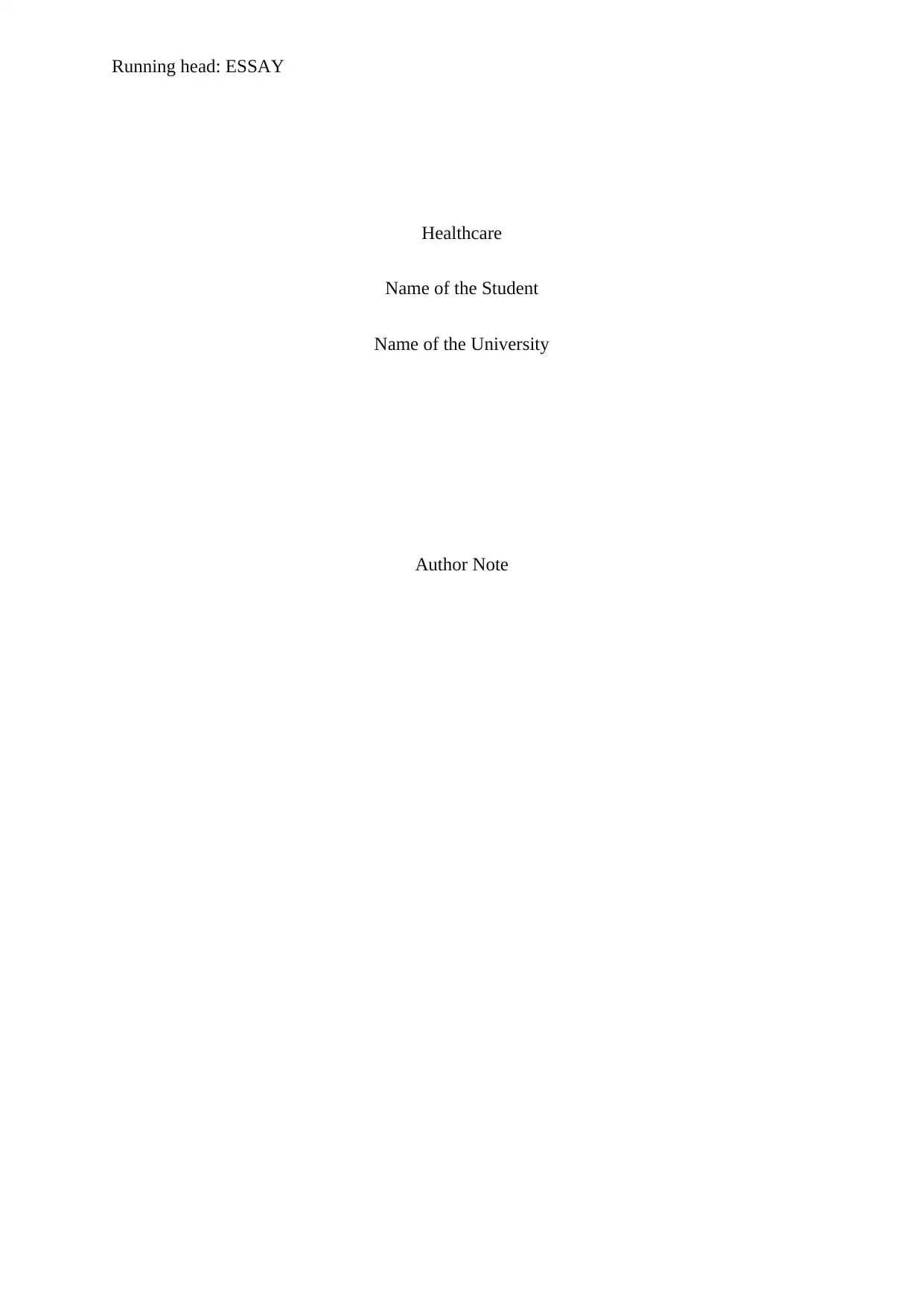
Running head: ESSAY
Healthcare
Name of the Student
Name of the University
Author Note
Healthcare
Name of the Student
Name of the University
Author Note
Paraphrase This Document
Need a fresh take? Get an instant paraphrase of this document with our AI Paraphraser
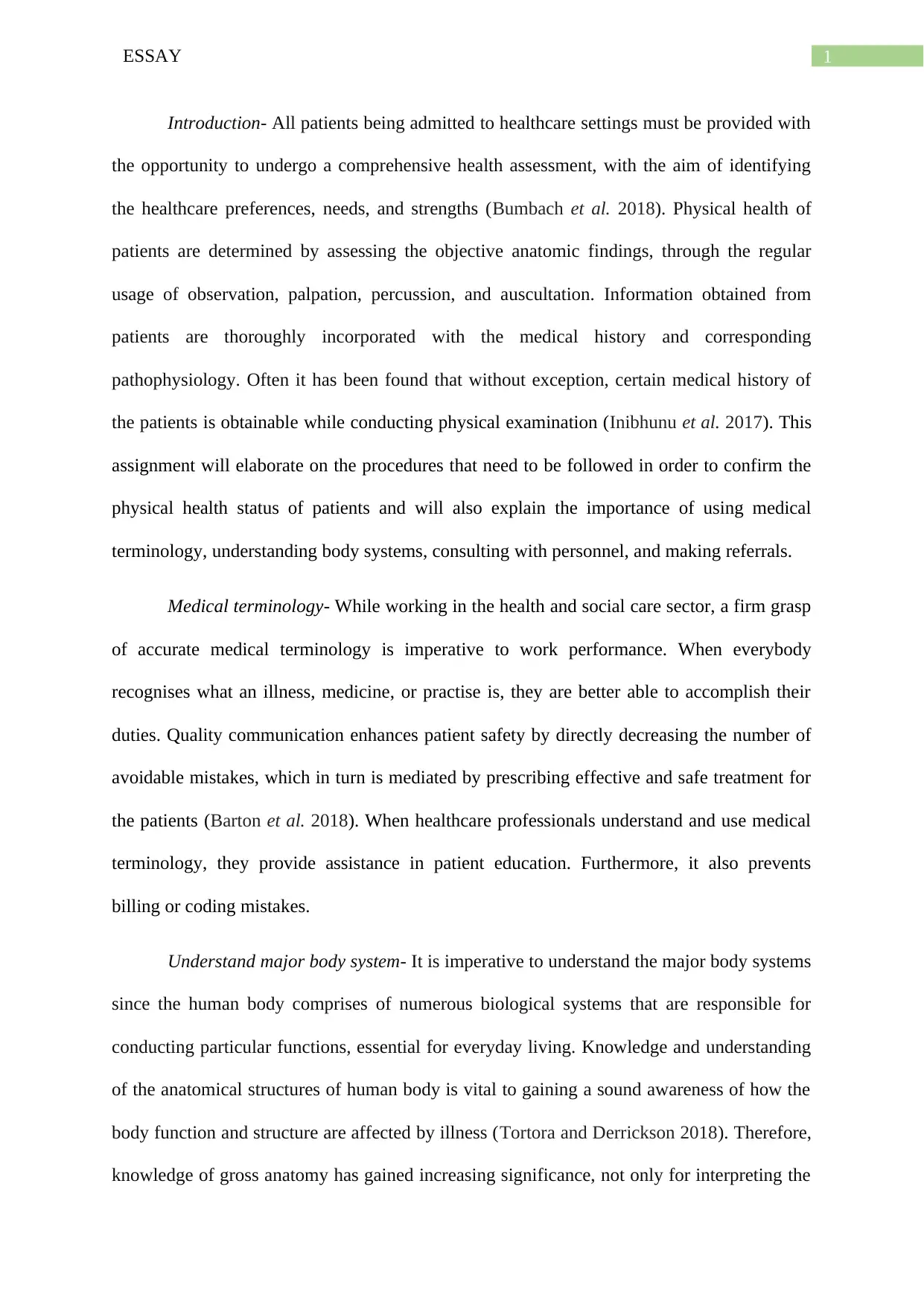
1ESSAY
Introduction- All patients being admitted to healthcare settings must be provided with
the opportunity to undergo a comprehensive health assessment, with the aim of identifying
the healthcare preferences, needs, and strengths (Bumbach et al. 2018). Physical health of
patients are determined by assessing the objective anatomic findings, through the regular
usage of observation, palpation, percussion, and auscultation. Information obtained from
patients are thoroughly incorporated with the medical history and corresponding
pathophysiology. Often it has been found that without exception, certain medical history of
the patients is obtainable while conducting physical examination (Inibhunu et al. 2017). This
assignment will elaborate on the procedures that need to be followed in order to confirm the
physical health status of patients and will also explain the importance of using medical
terminology, understanding body systems, consulting with personnel, and making referrals.
Medical terminology- While working in the health and social care sector, a firm grasp
of accurate medical terminology is imperative to work performance. When everybody
recognises what an illness, medicine, or practise is, they are better able to accomplish their
duties. Quality communication enhances patient safety by directly decreasing the number of
avoidable mistakes, which in turn is mediated by prescribing effective and safe treatment for
the patients (Barton et al. 2018). When healthcare professionals understand and use medical
terminology, they provide assistance in patient education. Furthermore, it also prevents
billing or coding mistakes.
Understand major body system- It is imperative to understand the major body systems
since the human body comprises of numerous biological systems that are responsible for
conducting particular functions, essential for everyday living. Knowledge and understanding
of the anatomical structures of human body is vital to gaining a sound awareness of how the
body function and structure are affected by illness (Tortora and Derrickson 2018). Therefore,
knowledge of gross anatomy has gained increasing significance, not only for interpreting the
Introduction- All patients being admitted to healthcare settings must be provided with
the opportunity to undergo a comprehensive health assessment, with the aim of identifying
the healthcare preferences, needs, and strengths (Bumbach et al. 2018). Physical health of
patients are determined by assessing the objective anatomic findings, through the regular
usage of observation, palpation, percussion, and auscultation. Information obtained from
patients are thoroughly incorporated with the medical history and corresponding
pathophysiology. Often it has been found that without exception, certain medical history of
the patients is obtainable while conducting physical examination (Inibhunu et al. 2017). This
assignment will elaborate on the procedures that need to be followed in order to confirm the
physical health status of patients and will also explain the importance of using medical
terminology, understanding body systems, consulting with personnel, and making referrals.
Medical terminology- While working in the health and social care sector, a firm grasp
of accurate medical terminology is imperative to work performance. When everybody
recognises what an illness, medicine, or practise is, they are better able to accomplish their
duties. Quality communication enhances patient safety by directly decreasing the number of
avoidable mistakes, which in turn is mediated by prescribing effective and safe treatment for
the patients (Barton et al. 2018). When healthcare professionals understand and use medical
terminology, they provide assistance in patient education. Furthermore, it also prevents
billing or coding mistakes.
Understand major body system- It is imperative to understand the major body systems
since the human body comprises of numerous biological systems that are responsible for
conducting particular functions, essential for everyday living. Knowledge and understanding
of the anatomical structures of human body is vital to gaining a sound awareness of how the
body function and structure are affected by illness (Tortora and Derrickson 2018). Therefore,
knowledge of gross anatomy has gained increasing significance, not only for interpreting the
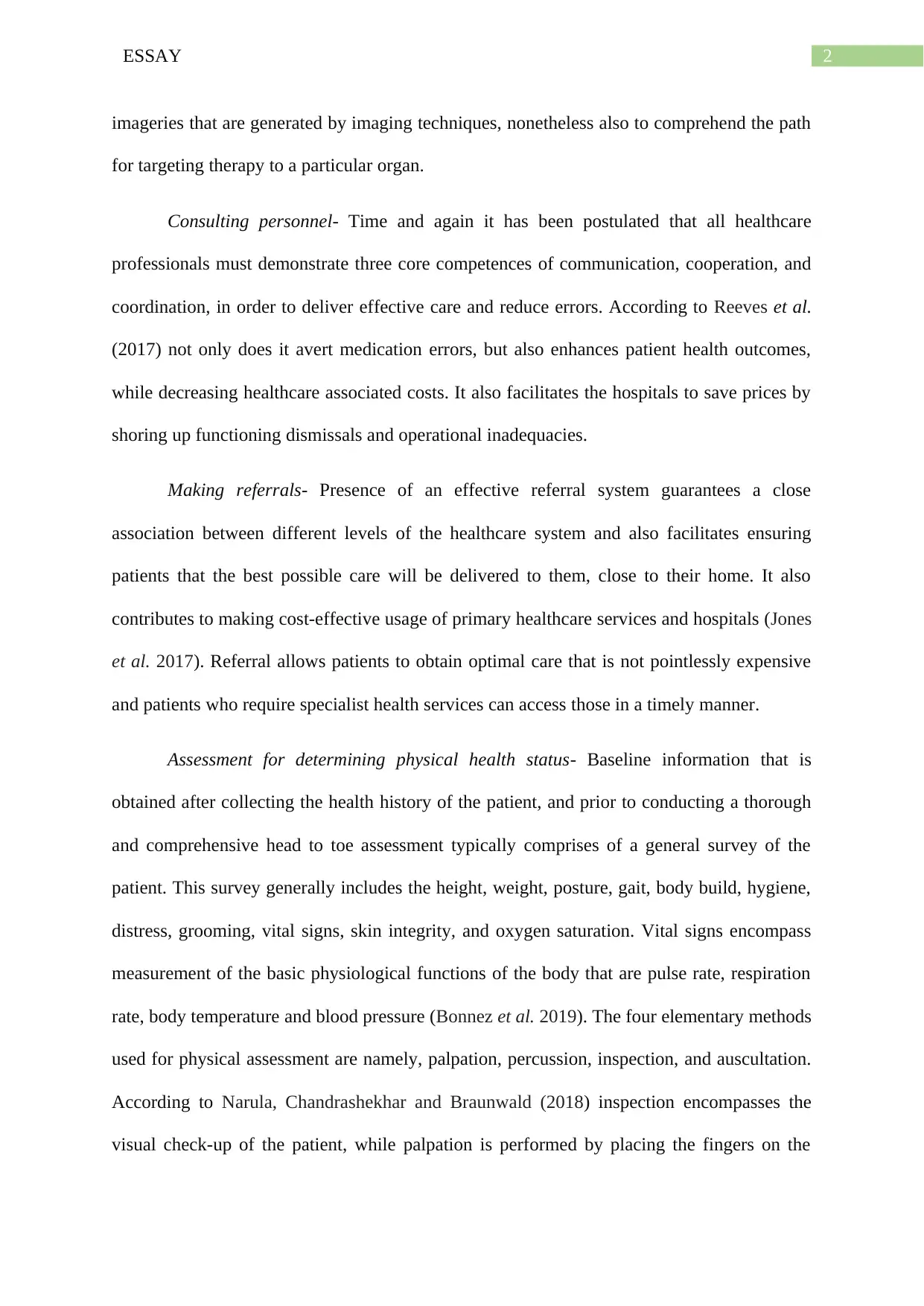
2ESSAY
imageries that are generated by imaging techniques, nonetheless also to comprehend the path
for targeting therapy to a particular organ.
Consulting personnel- Time and again it has been postulated that all healthcare
professionals must demonstrate three core competences of communication, cooperation, and
coordination, in order to deliver effective care and reduce errors. According to Reeves et al.
(2017) not only does it avert medication errors, but also enhances patient health outcomes,
while decreasing healthcare associated costs. It also facilitates the hospitals to save prices by
shoring up functioning dismissals and operational inadequacies.
Making referrals- Presence of an effective referral system guarantees a close
association between different levels of the healthcare system and also facilitates ensuring
patients that the best possible care will be delivered to them, close to their home. It also
contributes to making cost-effective usage of primary healthcare services and hospitals (Jones
et al. 2017). Referral allows patients to obtain optimal care that is not pointlessly expensive
and patients who require specialist health services can access those in a timely manner.
Assessment for determining physical health status- Baseline information that is
obtained after collecting the health history of the patient, and prior to conducting a thorough
and comprehensive head to toe assessment typically comprises of a general survey of the
patient. This survey generally includes the height, weight, posture, gait, body build, hygiene,
distress, grooming, vital signs, skin integrity, and oxygen saturation. Vital signs encompass
measurement of the basic physiological functions of the body that are pulse rate, respiration
rate, body temperature and blood pressure (Bonnez et al. 2019). The four elementary methods
used for physical assessment are namely, palpation, percussion, inspection, and auscultation.
According to Narula, Chandrashekhar and Braunwald (2018) inspection encompasses the
visual check-up of the patient, while palpation is performed by placing the fingers on the
imageries that are generated by imaging techniques, nonetheless also to comprehend the path
for targeting therapy to a particular organ.
Consulting personnel- Time and again it has been postulated that all healthcare
professionals must demonstrate three core competences of communication, cooperation, and
coordination, in order to deliver effective care and reduce errors. According to Reeves et al.
(2017) not only does it avert medication errors, but also enhances patient health outcomes,
while decreasing healthcare associated costs. It also facilitates the hospitals to save prices by
shoring up functioning dismissals and operational inadequacies.
Making referrals- Presence of an effective referral system guarantees a close
association between different levels of the healthcare system and also facilitates ensuring
patients that the best possible care will be delivered to them, close to their home. It also
contributes to making cost-effective usage of primary healthcare services and hospitals (Jones
et al. 2017). Referral allows patients to obtain optimal care that is not pointlessly expensive
and patients who require specialist health services can access those in a timely manner.
Assessment for determining physical health status- Baseline information that is
obtained after collecting the health history of the patient, and prior to conducting a thorough
and comprehensive head to toe assessment typically comprises of a general survey of the
patient. This survey generally includes the height, weight, posture, gait, body build, hygiene,
distress, grooming, vital signs, skin integrity, and oxygen saturation. Vital signs encompass
measurement of the basic physiological functions of the body that are pulse rate, respiration
rate, body temperature and blood pressure (Bonnez et al. 2019). The four elementary methods
used for physical assessment are namely, palpation, percussion, inspection, and auscultation.
According to Narula, Chandrashekhar and Braunwald (2018) inspection encompasses the
visual check-up of the patient, while palpation is performed by placing the fingers on the
⊘ This is a preview!⊘
Do you want full access?
Subscribe today to unlock all pages.

Trusted by 1+ million students worldwide
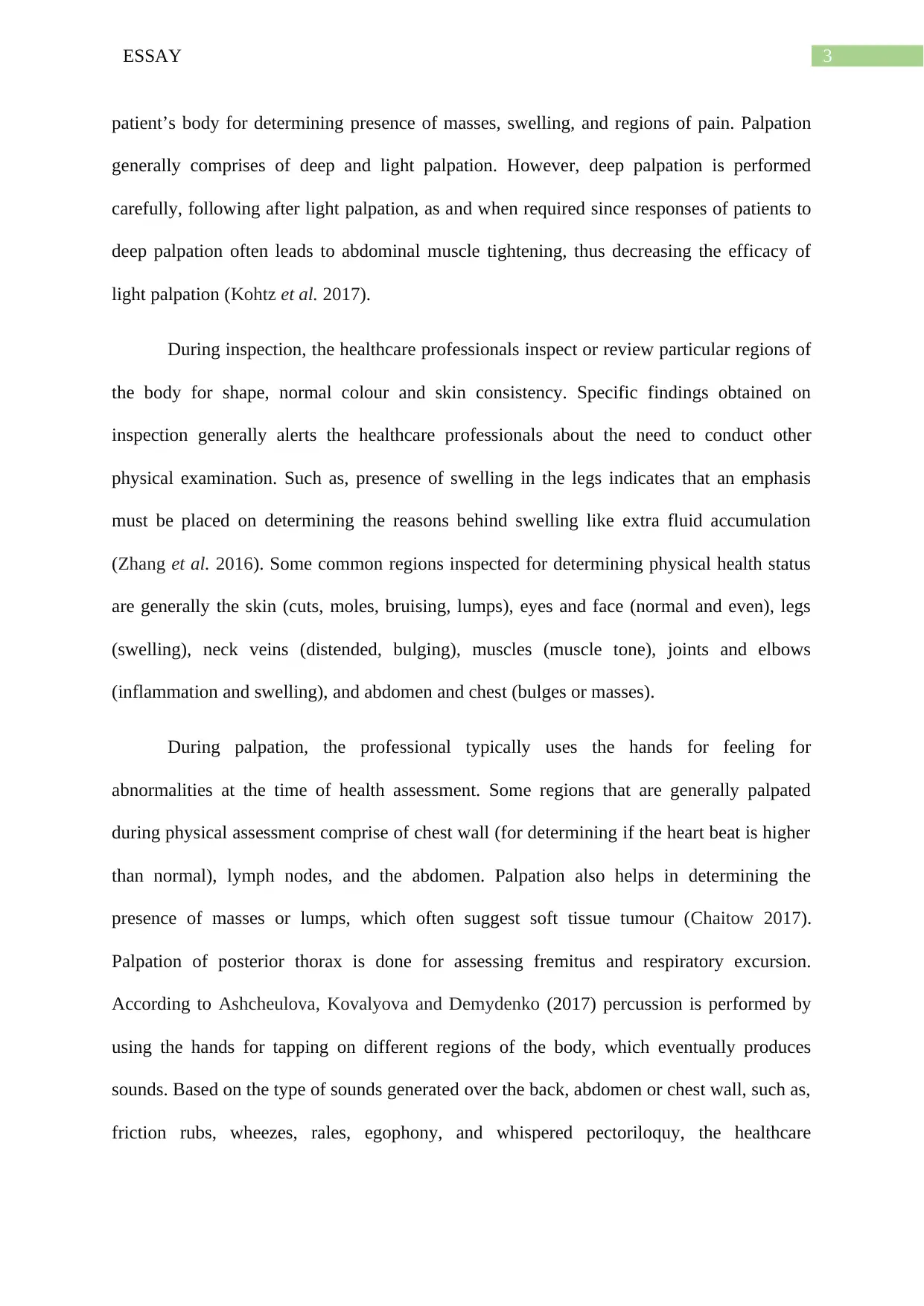
3ESSAY
patient’s body for determining presence of masses, swelling, and regions of pain. Palpation
generally comprises of deep and light palpation. However, deep palpation is performed
carefully, following after light palpation, as and when required since responses of patients to
deep palpation often leads to abdominal muscle tightening, thus decreasing the efficacy of
light palpation (Kohtz et al. 2017).
During inspection, the healthcare professionals inspect or review particular regions of
the body for shape, normal colour and skin consistency. Specific findings obtained on
inspection generally alerts the healthcare professionals about the need to conduct other
physical examination. Such as, presence of swelling in the legs indicates that an emphasis
must be placed on determining the reasons behind swelling like extra fluid accumulation
(Zhang et al. 2016). Some common regions inspected for determining physical health status
are generally the skin (cuts, moles, bruising, lumps), eyes and face (normal and even), legs
(swelling), neck veins (distended, bulging), muscles (muscle tone), joints and elbows
(inflammation and swelling), and abdomen and chest (bulges or masses).
During palpation, the professional typically uses the hands for feeling for
abnormalities at the time of health assessment. Some regions that are generally palpated
during physical assessment comprise of chest wall (for determining if the heart beat is higher
than normal), lymph nodes, and the abdomen. Palpation also helps in determining the
presence of masses or lumps, which often suggest soft tissue tumour (Chaitow 2017).
Palpation of posterior thorax is done for assessing fremitus and respiratory excursion.
According to Ashcheulova, Kovalyova and Demydenko (2017) percussion is performed by
using the hands for tapping on different regions of the body, which eventually produces
sounds. Based on the type of sounds generated over the back, abdomen or chest wall, such as,
friction rubs, wheezes, rales, egophony, and whispered pectoriloquy, the healthcare
patient’s body for determining presence of masses, swelling, and regions of pain. Palpation
generally comprises of deep and light palpation. However, deep palpation is performed
carefully, following after light palpation, as and when required since responses of patients to
deep palpation often leads to abdominal muscle tightening, thus decreasing the efficacy of
light palpation (Kohtz et al. 2017).
During inspection, the healthcare professionals inspect or review particular regions of
the body for shape, normal colour and skin consistency. Specific findings obtained on
inspection generally alerts the healthcare professionals about the need to conduct other
physical examination. Such as, presence of swelling in the legs indicates that an emphasis
must be placed on determining the reasons behind swelling like extra fluid accumulation
(Zhang et al. 2016). Some common regions inspected for determining physical health status
are generally the skin (cuts, moles, bruising, lumps), eyes and face (normal and even), legs
(swelling), neck veins (distended, bulging), muscles (muscle tone), joints and elbows
(inflammation and swelling), and abdomen and chest (bulges or masses).
During palpation, the professional typically uses the hands for feeling for
abnormalities at the time of health assessment. Some regions that are generally palpated
during physical assessment comprise of chest wall (for determining if the heart beat is higher
than normal), lymph nodes, and the abdomen. Palpation also helps in determining the
presence of masses or lumps, which often suggest soft tissue tumour (Chaitow 2017).
Palpation of posterior thorax is done for assessing fremitus and respiratory excursion.
According to Ashcheulova, Kovalyova and Demydenko (2017) percussion is performed by
using the hands for tapping on different regions of the body, which eventually produces
sounds. Based on the type of sounds generated over the back, abdomen or chest wall, such as,
friction rubs, wheezes, rales, egophony, and whispered pectoriloquy, the healthcare
Paraphrase This Document
Need a fresh take? Get an instant paraphrase of this document with our AI Paraphraser
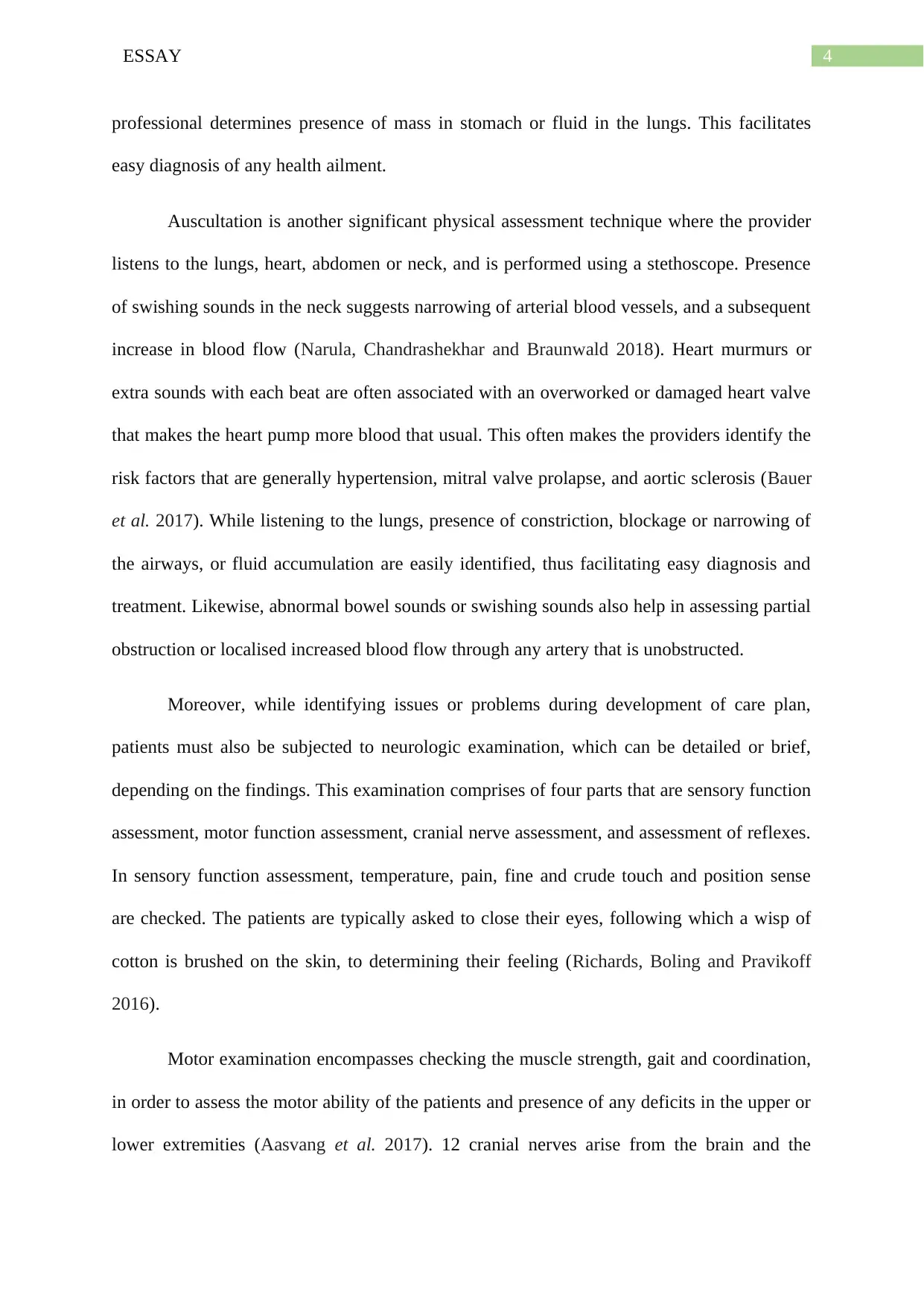
4ESSAY
professional determines presence of mass in stomach or fluid in the lungs. This facilitates
easy diagnosis of any health ailment.
Auscultation is another significant physical assessment technique where the provider
listens to the lungs, heart, abdomen or neck, and is performed using a stethoscope. Presence
of swishing sounds in the neck suggests narrowing of arterial blood vessels, and a subsequent
increase in blood flow (Narula, Chandrashekhar and Braunwald 2018). Heart murmurs or
extra sounds with each beat are often associated with an overworked or damaged heart valve
that makes the heart pump more blood that usual. This often makes the providers identify the
risk factors that are generally hypertension, mitral valve prolapse, and aortic sclerosis (Bauer
et al. 2017). While listening to the lungs, presence of constriction, blockage or narrowing of
the airways, or fluid accumulation are easily identified, thus facilitating easy diagnosis and
treatment. Likewise, abnormal bowel sounds or swishing sounds also help in assessing partial
obstruction or localised increased blood flow through any artery that is unobstructed.
Moreover, while identifying issues or problems during development of care plan,
patients must also be subjected to neurologic examination, which can be detailed or brief,
depending on the findings. This examination comprises of four parts that are sensory function
assessment, motor function assessment, cranial nerve assessment, and assessment of reflexes.
In sensory function assessment, temperature, pain, fine and crude touch and position sense
are checked. The patients are typically asked to close their eyes, following which a wisp of
cotton is brushed on the skin, to determining their feeling (Richards, Boling and Pravikoff
2016).
Motor examination encompasses checking the muscle strength, gait and coordination,
in order to assess the motor ability of the patients and presence of any deficits in the upper or
lower extremities (Aasvang et al. 2017). 12 cranial nerves arise from the brain and the
professional determines presence of mass in stomach or fluid in the lungs. This facilitates
easy diagnosis of any health ailment.
Auscultation is another significant physical assessment technique where the provider
listens to the lungs, heart, abdomen or neck, and is performed using a stethoscope. Presence
of swishing sounds in the neck suggests narrowing of arterial blood vessels, and a subsequent
increase in blood flow (Narula, Chandrashekhar and Braunwald 2018). Heart murmurs or
extra sounds with each beat are often associated with an overworked or damaged heart valve
that makes the heart pump more blood that usual. This often makes the providers identify the
risk factors that are generally hypertension, mitral valve prolapse, and aortic sclerosis (Bauer
et al. 2017). While listening to the lungs, presence of constriction, blockage or narrowing of
the airways, or fluid accumulation are easily identified, thus facilitating easy diagnosis and
treatment. Likewise, abnormal bowel sounds or swishing sounds also help in assessing partial
obstruction or localised increased blood flow through any artery that is unobstructed.
Moreover, while identifying issues or problems during development of care plan,
patients must also be subjected to neurologic examination, which can be detailed or brief,
depending on the findings. This examination comprises of four parts that are sensory function
assessment, motor function assessment, cranial nerve assessment, and assessment of reflexes.
In sensory function assessment, temperature, pain, fine and crude touch and position sense
are checked. The patients are typically asked to close their eyes, following which a wisp of
cotton is brushed on the skin, to determining their feeling (Richards, Boling and Pravikoff
2016).
Motor examination encompasses checking the muscle strength, gait and coordination,
in order to assess the motor ability of the patients and presence of any deficits in the upper or
lower extremities (Aasvang et al. 2017). 12 cranial nerves arise from the brain and the
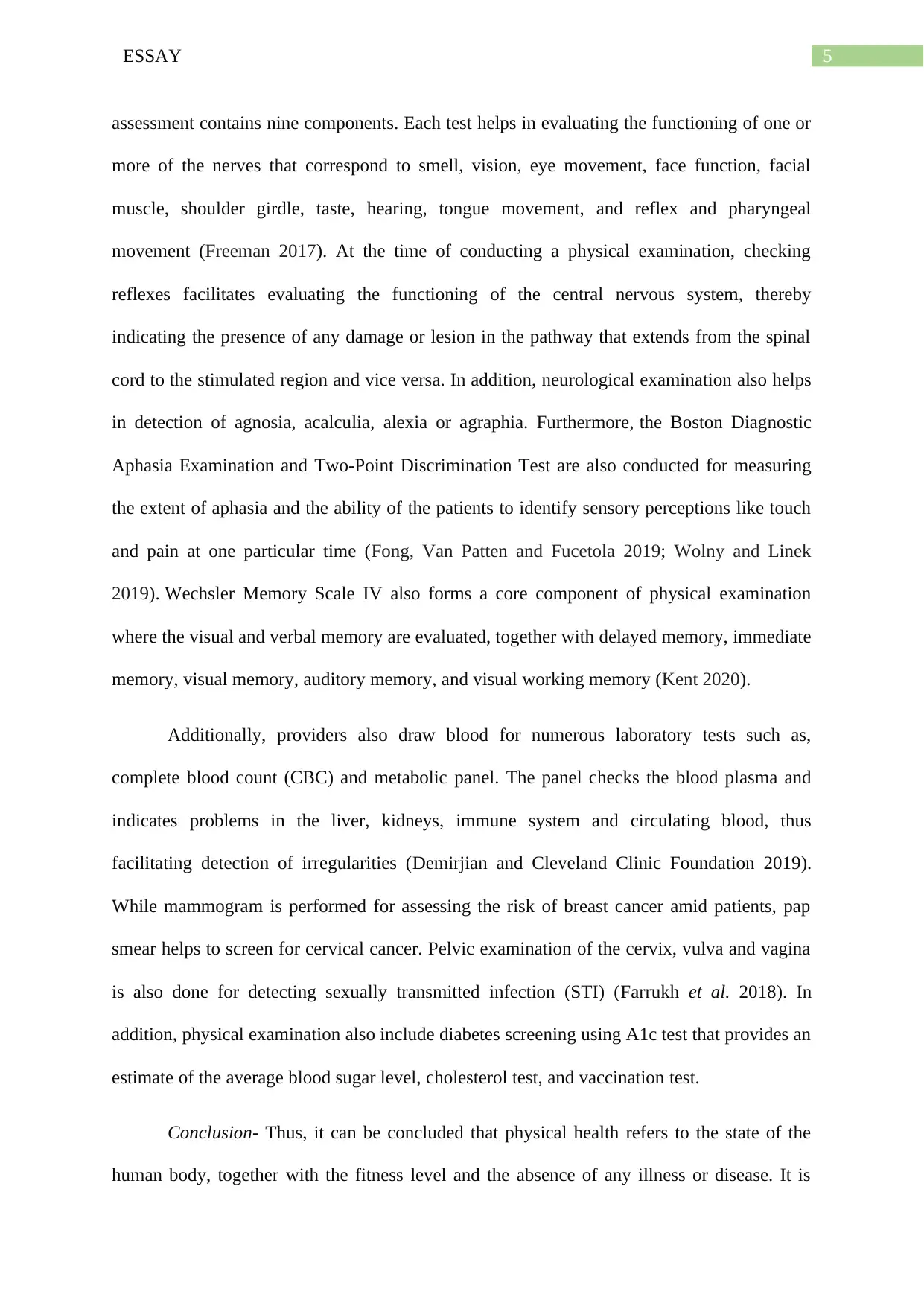
5ESSAY
assessment contains nine components. Each test helps in evaluating the functioning of one or
more of the nerves that correspond to smell, vision, eye movement, face function, facial
muscle, shoulder girdle, taste, hearing, tongue movement, and reflex and pharyngeal
movement (Freeman 2017). At the time of conducting a physical examination, checking
reflexes facilitates evaluating the functioning of the central nervous system, thereby
indicating the presence of any damage or lesion in the pathway that extends from the spinal
cord to the stimulated region and vice versa. In addition, neurological examination also helps
in detection of agnosia, acalculia, alexia or agraphia. Furthermore, the Boston Diagnostic
Aphasia Examination and Two-Point Discrimination Test are also conducted for measuring
the extent of aphasia and the ability of the patients to identify sensory perceptions like touch
and pain at one particular time (Fong, Van Patten and Fucetola 2019; Wolny and Linek
2019). Wechsler Memory Scale IV also forms a core component of physical examination
where the visual and verbal memory are evaluated, together with delayed memory, immediate
memory, visual memory, auditory memory, and visual working memory (Kent 2020).
Additionally, providers also draw blood for numerous laboratory tests such as,
complete blood count (CBC) and metabolic panel. The panel checks the blood plasma and
indicates problems in the liver, kidneys, immune system and circulating blood, thus
facilitating detection of irregularities (Demirjian and Cleveland Clinic Foundation 2019).
While mammogram is performed for assessing the risk of breast cancer amid patients, pap
smear helps to screen for cervical cancer. Pelvic examination of the cervix, vulva and vagina
is also done for detecting sexually transmitted infection (STI) (Farrukh et al. 2018). In
addition, physical examination also include diabetes screening using A1c test that provides an
estimate of the average blood sugar level, cholesterol test, and vaccination test.
Conclusion- Thus, it can be concluded that physical health refers to the state of the
human body, together with the fitness level and the absence of any illness or disease. It is
assessment contains nine components. Each test helps in evaluating the functioning of one or
more of the nerves that correspond to smell, vision, eye movement, face function, facial
muscle, shoulder girdle, taste, hearing, tongue movement, and reflex and pharyngeal
movement (Freeman 2017). At the time of conducting a physical examination, checking
reflexes facilitates evaluating the functioning of the central nervous system, thereby
indicating the presence of any damage or lesion in the pathway that extends from the spinal
cord to the stimulated region and vice versa. In addition, neurological examination also helps
in detection of agnosia, acalculia, alexia or agraphia. Furthermore, the Boston Diagnostic
Aphasia Examination and Two-Point Discrimination Test are also conducted for measuring
the extent of aphasia and the ability of the patients to identify sensory perceptions like touch
and pain at one particular time (Fong, Van Patten and Fucetola 2019; Wolny and Linek
2019). Wechsler Memory Scale IV also forms a core component of physical examination
where the visual and verbal memory are evaluated, together with delayed memory, immediate
memory, visual memory, auditory memory, and visual working memory (Kent 2020).
Additionally, providers also draw blood for numerous laboratory tests such as,
complete blood count (CBC) and metabolic panel. The panel checks the blood plasma and
indicates problems in the liver, kidneys, immune system and circulating blood, thus
facilitating detection of irregularities (Demirjian and Cleveland Clinic Foundation 2019).
While mammogram is performed for assessing the risk of breast cancer amid patients, pap
smear helps to screen for cervical cancer. Pelvic examination of the cervix, vulva and vagina
is also done for detecting sexually transmitted infection (STI) (Farrukh et al. 2018). In
addition, physical examination also include diabetes screening using A1c test that provides an
estimate of the average blood sugar level, cholesterol test, and vaccination test.
Conclusion- Thus, it can be concluded that physical health refers to the state of the
human body, together with the fitness level and the absence of any illness or disease. It is
⊘ This is a preview!⊘
Do you want full access?
Subscribe today to unlock all pages.

Trusted by 1+ million students worldwide
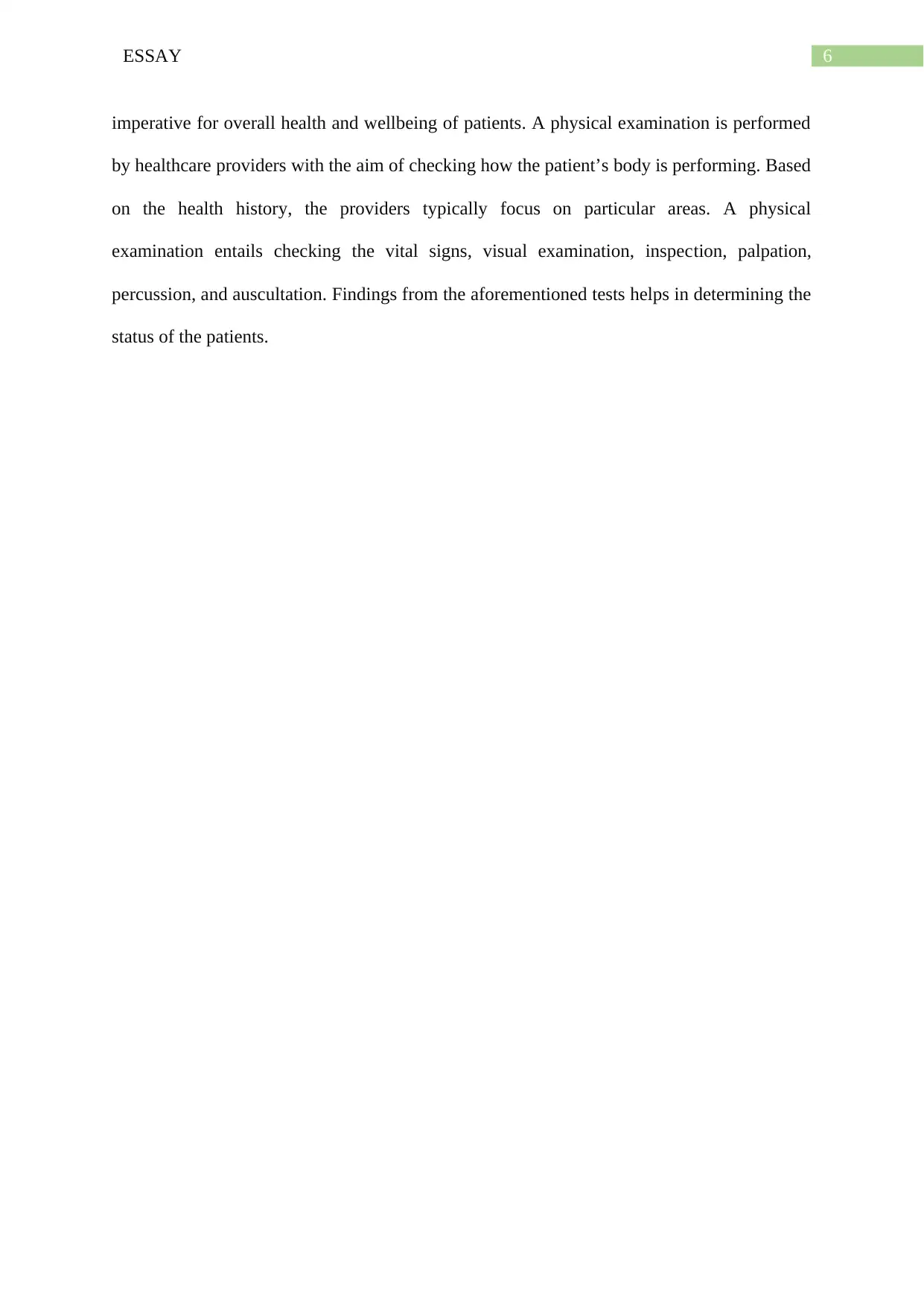
6ESSAY
imperative for overall health and wellbeing of patients. A physical examination is performed
by healthcare providers with the aim of checking how the patient’s body is performing. Based
on the health history, the providers typically focus on particular areas. A physical
examination entails checking the vital signs, visual examination, inspection, palpation,
percussion, and auscultation. Findings from the aforementioned tests helps in determining the
status of the patients.
imperative for overall health and wellbeing of patients. A physical examination is performed
by healthcare providers with the aim of checking how the patient’s body is performing. Based
on the health history, the providers typically focus on particular areas. A physical
examination entails checking the vital signs, visual examination, inspection, palpation,
percussion, and auscultation. Findings from the aforementioned tests helps in determining the
status of the patients.
Paraphrase This Document
Need a fresh take? Get an instant paraphrase of this document with our AI Paraphraser
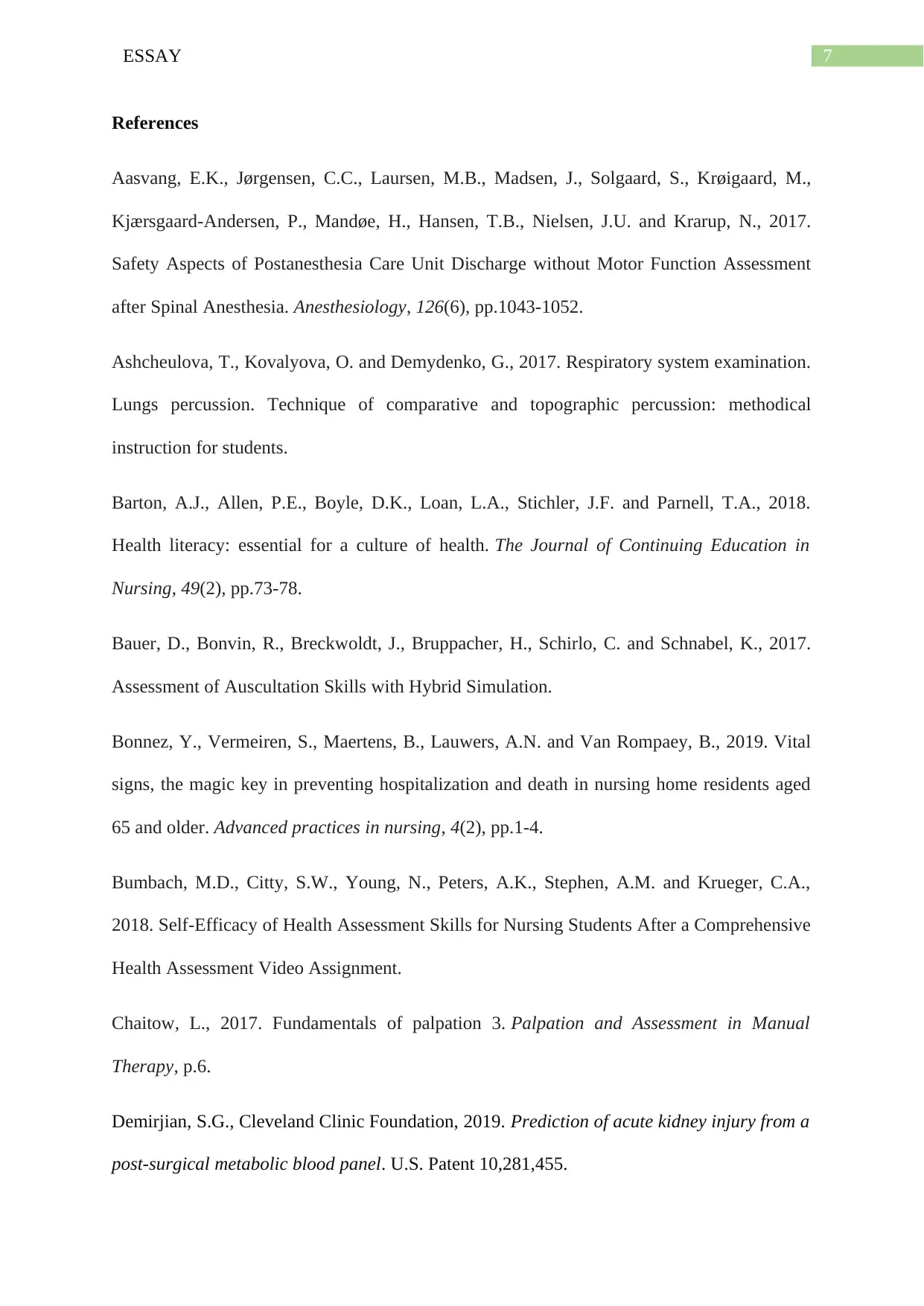
7ESSAY
References
Aasvang, E.K., Jørgensen, C.C., Laursen, M.B., Madsen, J., Solgaard, S., Krøigaard, M.,
Kjærsgaard-Andersen, P., Mandøe, H., Hansen, T.B., Nielsen, J.U. and Krarup, N., 2017.
Safety Aspects of Postanesthesia Care Unit Discharge without Motor Function Assessment
after Spinal Anesthesia. Anesthesiology, 126(6), pp.1043-1052.
Ashcheulova, T., Kovalyova, O. and Demydenko, G., 2017. Respiratory system examination.
Lungs percussion. Technique of comparative and topographic percussion: mеthodical
instruction for students.
Barton, A.J., Allen, P.E., Boyle, D.K., Loan, L.A., Stichler, J.F. and Parnell, T.A., 2018.
Health literacy: essential for a culture of health. The Journal of Continuing Education in
Nursing, 49(2), pp.73-78.
Bauer, D., Bonvin, R., Breckwoldt, J., Bruppacher, H., Schirlo, C. and Schnabel, K., 2017.
Assessment of Auscultation Skills with Hybrid Simulation.
Bonnez, Y., Vermeiren, S., Maertens, B., Lauwers, A.N. and Van Rompaey, B., 2019. Vital
signs, the magic key in preventing hospitalization and death in nursing home residents aged
65 and older. Advanced practices in nursing, 4(2), pp.1-4.
Bumbach, M.D., Citty, S.W., Young, N., Peters, A.K., Stephen, A.M. and Krueger, C.A.,
2018. Self-Efficacy of Health Assessment Skills for Nursing Students After a Comprehensive
Health Assessment Video Assignment.
Chaitow, L., 2017. Fundamentals of palpation 3. Palpation and Assessment in Manual
Therapy, p.6.
Demirjian, S.G., Cleveland Clinic Foundation, 2019. Prediction of acute kidney injury from a
post-surgical metabolic blood panel. U.S. Patent 10,281,455.
References
Aasvang, E.K., Jørgensen, C.C., Laursen, M.B., Madsen, J., Solgaard, S., Krøigaard, M.,
Kjærsgaard-Andersen, P., Mandøe, H., Hansen, T.B., Nielsen, J.U. and Krarup, N., 2017.
Safety Aspects of Postanesthesia Care Unit Discharge without Motor Function Assessment
after Spinal Anesthesia. Anesthesiology, 126(6), pp.1043-1052.
Ashcheulova, T., Kovalyova, O. and Demydenko, G., 2017. Respiratory system examination.
Lungs percussion. Technique of comparative and topographic percussion: mеthodical
instruction for students.
Barton, A.J., Allen, P.E., Boyle, D.K., Loan, L.A., Stichler, J.F. and Parnell, T.A., 2018.
Health literacy: essential for a culture of health. The Journal of Continuing Education in
Nursing, 49(2), pp.73-78.
Bauer, D., Bonvin, R., Breckwoldt, J., Bruppacher, H., Schirlo, C. and Schnabel, K., 2017.
Assessment of Auscultation Skills with Hybrid Simulation.
Bonnez, Y., Vermeiren, S., Maertens, B., Lauwers, A.N. and Van Rompaey, B., 2019. Vital
signs, the magic key in preventing hospitalization and death in nursing home residents aged
65 and older. Advanced practices in nursing, 4(2), pp.1-4.
Bumbach, M.D., Citty, S.W., Young, N., Peters, A.K., Stephen, A.M. and Krueger, C.A.,
2018. Self-Efficacy of Health Assessment Skills for Nursing Students After a Comprehensive
Health Assessment Video Assignment.
Chaitow, L., 2017. Fundamentals of palpation 3. Palpation and Assessment in Manual
Therapy, p.6.
Demirjian, S.G., Cleveland Clinic Foundation, 2019. Prediction of acute kidney injury from a
post-surgical metabolic blood panel. U.S. Patent 10,281,455.
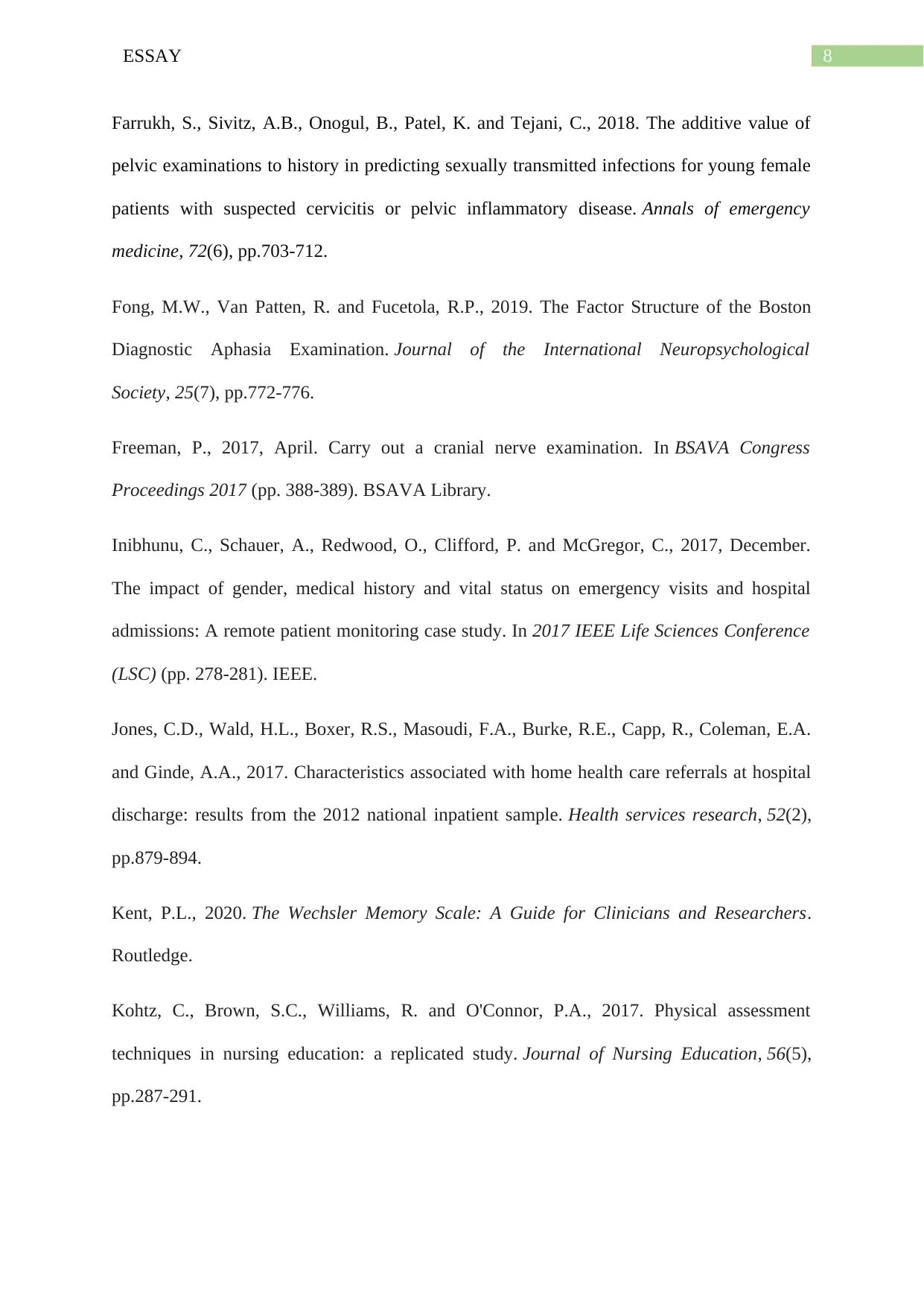
8ESSAY
Farrukh, S., Sivitz, A.B., Onogul, B., Patel, K. and Tejani, C., 2018. The additive value of
pelvic examinations to history in predicting sexually transmitted infections for young female
patients with suspected cervicitis or pelvic inflammatory disease. Annals of emergency
medicine, 72(6), pp.703-712.
Fong, M.W., Van Patten, R. and Fucetola, R.P., 2019. The Factor Structure of the Boston
Diagnostic Aphasia Examination. Journal of the International Neuropsychological
Society, 25(7), pp.772-776.
Freeman, P., 2017, April. Carry out a cranial nerve examination. In BSAVA Congress
Proceedings 2017 (pp. 388-389). BSAVA Library.
Inibhunu, C., Schauer, A., Redwood, O., Clifford, P. and McGregor, C., 2017, December.
The impact of gender, medical history and vital status on emergency visits and hospital
admissions: A remote patient monitoring case study. In 2017 IEEE Life Sciences Conference
(LSC) (pp. 278-281). IEEE.
Jones, C.D., Wald, H.L., Boxer, R.S., Masoudi, F.A., Burke, R.E., Capp, R., Coleman, E.A.
and Ginde, A.A., 2017. Characteristics associated with home health care referrals at hospital
discharge: results from the 2012 national inpatient sample. Health services research, 52(2),
pp.879-894.
Kent, P.L., 2020. The Wechsler Memory Scale: A Guide for Clinicians and Researchers.
Routledge.
Kohtz, C., Brown, S.C., Williams, R. and O'Connor, P.A., 2017. Physical assessment
techniques in nursing education: a replicated study. Journal of Nursing Education, 56(5),
pp.287-291.
Farrukh, S., Sivitz, A.B., Onogul, B., Patel, K. and Tejani, C., 2018. The additive value of
pelvic examinations to history in predicting sexually transmitted infections for young female
patients with suspected cervicitis or pelvic inflammatory disease. Annals of emergency
medicine, 72(6), pp.703-712.
Fong, M.W., Van Patten, R. and Fucetola, R.P., 2019. The Factor Structure of the Boston
Diagnostic Aphasia Examination. Journal of the International Neuropsychological
Society, 25(7), pp.772-776.
Freeman, P., 2017, April. Carry out a cranial nerve examination. In BSAVA Congress
Proceedings 2017 (pp. 388-389). BSAVA Library.
Inibhunu, C., Schauer, A., Redwood, O., Clifford, P. and McGregor, C., 2017, December.
The impact of gender, medical history and vital status on emergency visits and hospital
admissions: A remote patient monitoring case study. In 2017 IEEE Life Sciences Conference
(LSC) (pp. 278-281). IEEE.
Jones, C.D., Wald, H.L., Boxer, R.S., Masoudi, F.A., Burke, R.E., Capp, R., Coleman, E.A.
and Ginde, A.A., 2017. Characteristics associated with home health care referrals at hospital
discharge: results from the 2012 national inpatient sample. Health services research, 52(2),
pp.879-894.
Kent, P.L., 2020. The Wechsler Memory Scale: A Guide for Clinicians and Researchers.
Routledge.
Kohtz, C., Brown, S.C., Williams, R. and O'Connor, P.A., 2017. Physical assessment
techniques in nursing education: a replicated study. Journal of Nursing Education, 56(5),
pp.287-291.
⊘ This is a preview!⊘
Do you want full access?
Subscribe today to unlock all pages.

Trusted by 1+ million students worldwide
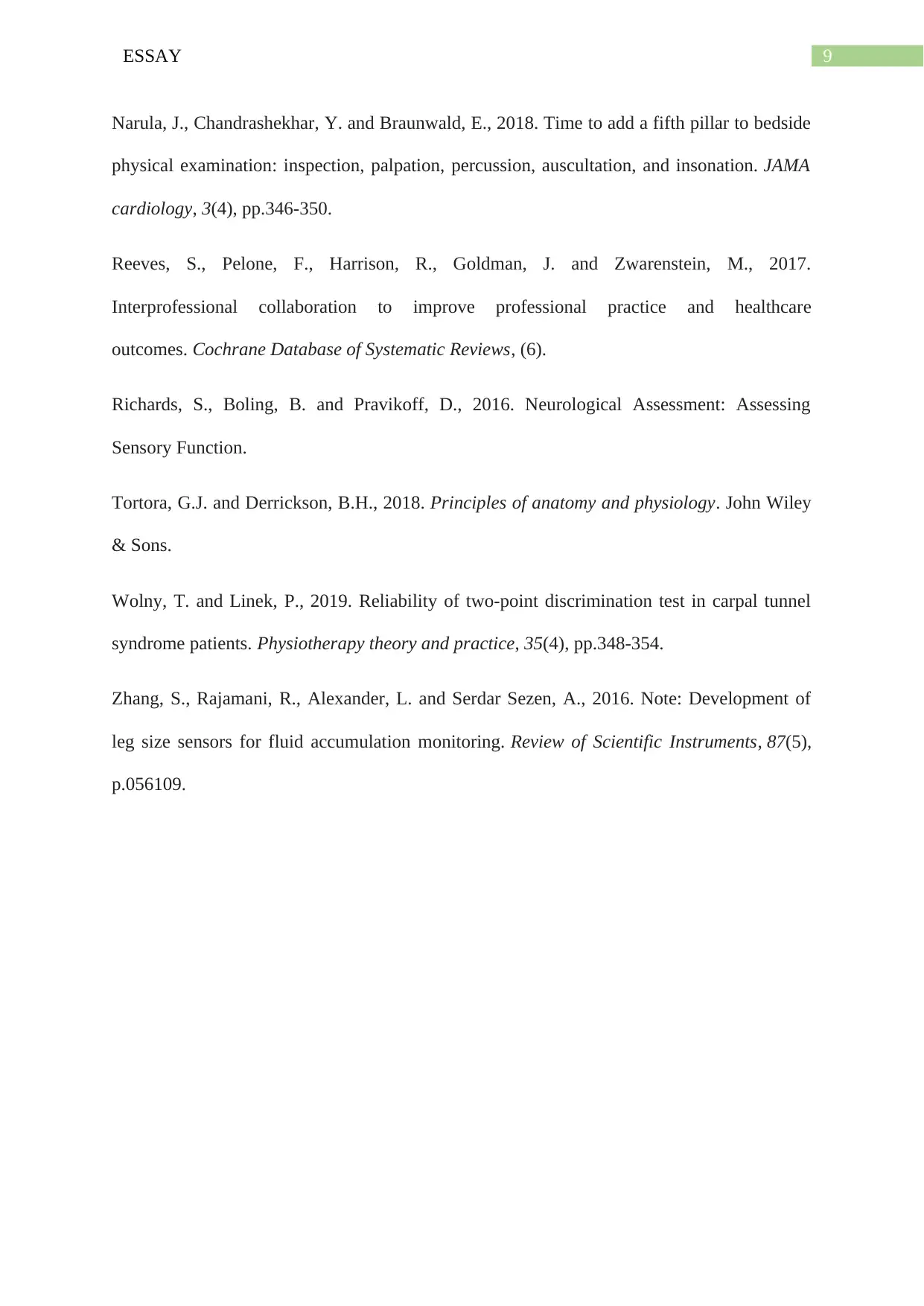
9ESSAY
Narula, J., Chandrashekhar, Y. and Braunwald, E., 2018. Time to add a fifth pillar to bedside
physical examination: inspection, palpation, percussion, auscultation, and insonation. JAMA
cardiology, 3(4), pp.346-350.
Reeves, S., Pelone, F., Harrison, R., Goldman, J. and Zwarenstein, M., 2017.
Interprofessional collaboration to improve professional practice and healthcare
outcomes. Cochrane Database of Systematic Reviews, (6).
Richards, S., Boling, B. and Pravikoff, D., 2016. Neurological Assessment: Assessing
Sensory Function.
Tortora, G.J. and Derrickson, B.H., 2018. Principles of anatomy and physiology. John Wiley
& Sons.
Wolny, T. and Linek, P., 2019. Reliability of two-point discrimination test in carpal tunnel
syndrome patients. Physiotherapy theory and practice, 35(4), pp.348-354.
Zhang, S., Rajamani, R., Alexander, L. and Serdar Sezen, A., 2016. Note: Development of
leg size sensors for fluid accumulation monitoring. Review of Scientific Instruments, 87(5),
p.056109.
Narula, J., Chandrashekhar, Y. and Braunwald, E., 2018. Time to add a fifth pillar to bedside
physical examination: inspection, palpation, percussion, auscultation, and insonation. JAMA
cardiology, 3(4), pp.346-350.
Reeves, S., Pelone, F., Harrison, R., Goldman, J. and Zwarenstein, M., 2017.
Interprofessional collaboration to improve professional practice and healthcare
outcomes. Cochrane Database of Systematic Reviews, (6).
Richards, S., Boling, B. and Pravikoff, D., 2016. Neurological Assessment: Assessing
Sensory Function.
Tortora, G.J. and Derrickson, B.H., 2018. Principles of anatomy and physiology. John Wiley
& Sons.
Wolny, T. and Linek, P., 2019. Reliability of two-point discrimination test in carpal tunnel
syndrome patients. Physiotherapy theory and practice, 35(4), pp.348-354.
Zhang, S., Rajamani, R., Alexander, L. and Serdar Sezen, A., 2016. Note: Development of
leg size sensors for fluid accumulation monitoring. Review of Scientific Instruments, 87(5),
p.056109.
1 out of 10
Related Documents
Your All-in-One AI-Powered Toolkit for Academic Success.
+13062052269
info@desklib.com
Available 24*7 on WhatsApp / Email
![[object Object]](/_next/static/media/star-bottom.7253800d.svg)
Unlock your academic potential
Copyright © 2020–2025 A2Z Services. All Rights Reserved. Developed and managed by ZUCOL.





